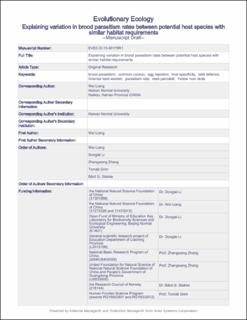| dc.contributor.author | Li, Donglai | |
| dc.contributor.author | Zhang, Zhengwang | |
| dc.contributor.author | Grim, Tomas | |
| dc.contributor.author | Liang, Wei | |
| dc.contributor.author | Stokke, Bård Gunnar | |
| dc.date.accessioned | 2023-05-12T12:52:54Z | |
| dc.date.available | 2023-05-12T12:52:54Z | |
| dc.date.created | 2016-08-09T15:20:16Z | |
| dc.date.issued | 2016 | |
| dc.identifier.citation | Evolutionary Ecology. 2016, 30 (5), 905-923. | en_US |
| dc.identifier.issn | 0269-7653 | |
| dc.identifier.uri | https://hdl.handle.net/11250/3067808 | |
| dc.description.abstract | Host specialization evolved in many parasite-host systems. Evolution and
maintenance of host specificity may be influenced by host life-history traits, active host
selection by the parasite, and host anti-parasite strategies. The relative importance of these
factors is poorly understood in situations that offer parasites a choice between hosts with
similar habitat requirements. The common cuckoo Cuculus canorus is a generalist parasite
on the species level, but individual females prefer particular host species. In reed beds of
the Yellow River Delta, China, two potential hosts with similar nest characteristics,
Oriental reed warblers Acrocephalus orientalis and reed parrotbills Paradoxornis heudei,
breed in sympatry. We found that warblers were parasitized at much higher rates than
parrotbills. Both hosts recognized and rejected non-mimetic model eggs well, indicating
that they have been involved in an arms-race with cuckoos. Cuckoo eggs closely resembled
warbler eggs, and such eggs were mostly accepted by warblers but rejected by parrotbills.
Only warblers recognized adult cuckoos as a specific threat. Both hosts were equally good
at raising cuckoo chicks. Low nest density, partial isolation by breeding time, small scale
differences in nest and nest site characteristics, and high rejection rates of natural cuckoo
eggs are likely cumulatively responsible for the low current parasitism rate in parrotbills.
This study emphasizes the importance of integrating the study of general host life-history
characteristics and specific anti-parasitism strategies of hosts across all breeding stages to
understand the evolution of host specificity. | en_US |
| dc.language.iso | eng | en_US |
| dc.subject | Brood parasitism | en_US |
| dc.subject | Common cuckoo | en_US |
| dc.subject | Egg rejection | en_US |
| dc.subject | Host specificity | en_US |
| dc.subject | Nest defence | en_US |
| dc.subject | Oriental reed warbler | en_US |
| dc.subject | Parasitism rate | en_US |
| dc.subject | Reed parrotbill | en_US |
| dc.subject | Yellow River Delta | en_US |
| dc.title | Explaining variation in brood parasitism rates between potential host species with similar habitat requirements | en_US |
| dc.type | Peer reviewed | en_US |
| dc.type | Journal article | en_US |
| dc.description.version | submittedVersion | en_US |
| dc.description.version | publishedVersion | en_US |
| dc.subject.nsi | VDP::Zoologiske og botaniske fag: 480 | en_US |
| dc.subject.nsi | VDP::Zoology and botany: 480 | en_US |
| dc.source.pagenumber | 905-923 | en_US |
| dc.source.volume | 30 | en_US |
| dc.source.journal | Evolutionary Ecology | en_US |
| dc.source.issue | 5 | en_US |
| dc.identifier.doi | 10.1007/s10682-016-9850-7 | |
| dc.identifier.cristin | 1371553 | |
| dc.relation.project | Norges forskningsråd: 218144 | en_US |
| cristin.unitcode | 7511,2,0,0 | |
| cristin.unitname | Avdeling for terrestrisk økologi | |
| cristin.ispublished | true | |
| cristin.fulltext | original | |
| cristin.fulltext | preprint | |
| cristin.qualitycode | 1 | |
